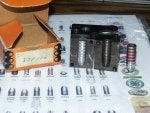.
I am reading all types of equations for bullet to land distance in the 38-55. Does it make a difference? Not in my rifles.
Of far greater importance to accuracy is Case length. Case length you say? Yep, because the 38-55 has a very shallow taper (6 degrees) from chamber to throat case length is important. The throat is the same diameter as the groove diameter so the oversized cast bullet will be swaged down in the throat long before lands (rifling) are encountered. Therefore, the case should not extend into the throat, otherwise the crimp will not be opened fully and a distorted bullet will result. Distorted bullets are never good for accuracy. Short cases cause other issues.
So how do we determine case length? The way that I use is to first determine what diameter cast bullet is to be loaded. Then load a dummy round with that bullet seated to the crimp groove but no crimp applied and see if it chambers with no undue effort, snug is good, very tight is not. The crimp will allow the round to seat deeper into the chamber and thus give a false fit indication. I begin with Starline long brass, 2.125 length, if it is too tight with the bullet of interest, I shorten the brass .010 and repeat the test. If the round is still too tight then shorten the case again. continue until a correct fit is obtained and you have your case length for that rifle. It works for me.
:tee:
I am reading all types of equations for bullet to land distance in the 38-55. Does it make a difference? Not in my rifles.
Of far greater importance to accuracy is Case length. Case length you say? Yep, because the 38-55 has a very shallow taper (6 degrees) from chamber to throat case length is important. The throat is the same diameter as the groove diameter so the oversized cast bullet will be swaged down in the throat long before lands (rifling) are encountered. Therefore, the case should not extend into the throat, otherwise the crimp will not be opened fully and a distorted bullet will result. Distorted bullets are never good for accuracy. Short cases cause other issues.
So how do we determine case length? The way that I use is to first determine what diameter cast bullet is to be loaded. Then load a dummy round with that bullet seated to the crimp groove but no crimp applied and see if it chambers with no undue effort, snug is good, very tight is not. The crimp will allow the round to seat deeper into the chamber and thus give a false fit indication. I begin with Starline long brass, 2.125 length, if it is too tight with the bullet of interest, I shorten the brass .010 and repeat the test. If the round is still too tight then shorten the case again. continue until a correct fit is obtained and you have your case length for that rifle. It works for me.
:tee:





